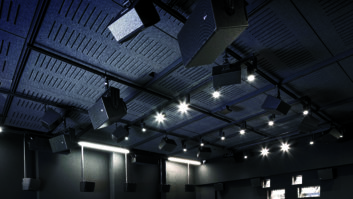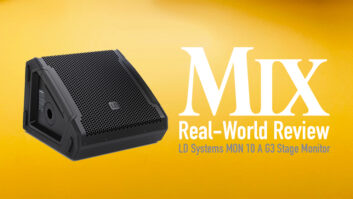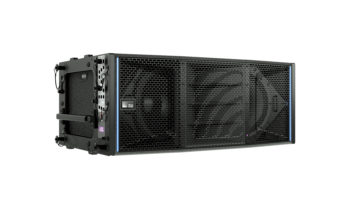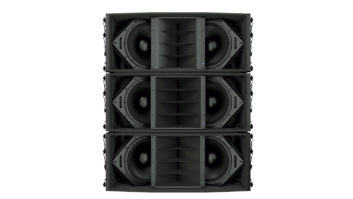Long established as a supplier of cutting-edge sound reinforcement systems, Meyer Sound has also made a significant impact in the realm of studio monitors. In 1991, Meyer’s landmark HD-1 speakers defined the model of the modern powered near-field studio monitor. Nearly a decade later, the company has now set its sights on revolutionizing the large-format monitor market.
In the most basic sense, the X-10 High-Resolution Linear Control Room Monitor is a two-way system, combining a 15-inch woofer and HF compression driver in a vented 30x31x21-inch (HxWxD) enclosure. Internal bi-amplification is capable of pushing the system to SPLs as high as 136 dB (at 1 m). Although this description is technically accurate, it could easily lead one to believe that the X-10 is ordinary. And the X-10 is anything but ordinary: It’s a two-way system that delivers extended bandwidth (22 to 17k Hz, +/-2 dB). It’s a horn system that doesn’t have a characteristic “horn” sound. It’s a large, high-SPL system that offers transient response that rivals (or bests) the performance of electrostatic panels, and by using a single LF driver, the designers have sidestepped the lobing and comb-filtering problems associated with dual-woofer designs.
Ironically, the key to the entire project came not from pro or consumer audio, but from an advanced feedback circuit developed by the University of California at Berkeley and licensed to Meyer Sound. “Normally, in designing loudspeakers, the industry works in small incremental improvements,” explains company president John Meyer, “but working with the university gave us a chance to try something completely new. They approached us with a technology based on computer-driven hydraulics [that had been] developed to help control jet fighters moving at three times the speed of sound. They thought the high-speed, multi-input servo systems they developed could be applied to loudspeakers.”
Meyer engineers took the concept and developed it into Pressure Sensing Active Control (PSAC), which places a pressure sensor-essentially a calibrated condenser microphone-in front of the woofer. The information picked up by the sensor is then sent to the PSAC comparator circuit inserted before the LF power amplifier, which compares the sensor data to the input and puts the two signals in precise alignment. The original project was designed and prototyped entirely in the digital domain, yet interestingly, a high-speed analog computer circuit was selected for the X-10 because of its real-time speed and wide dynamic range.
The other challenge in the X-10 project was designing an ultrahigh-output woofer that could keep up with the SPL requirements typically associated with dual-woofer designs. “We spent about two-and-a-half years trying to implement this prototype,” says Meyer. “We used about 28 neodymium magnets to build the magnet structure so we’d have a long 1-inch throw where the voice coil always stayed within the magnetic field. It’s not like some woofers, which have a low-gauss/big coil-ours is a small coil/high 16k-gauss [magnetic flux equal to 1.5 million Maxwells] design. We can get as much power out of a single 15 as we could from a double 18, producing 118 dB from a tone outdoors at 30 cycles at some reasonable distortion figure.”
On the HF side, the X-10 uses Meyer Sound’s 2010, a 4-inch compression driver with an aluminum-alloy diaphragm paired with a neodymium magnet and a ferrofluid-cooled voice coil. The driver is coupled to a 90Dx45D constant-Q waveguide designed to provide a wide, even sweet spot. Both LF and HF drivers are powered by Class-AB/H MOSFET amps, with 1,200 watts for the woofer and 620 watts for the compression driver.
For applications requiring an additional subwoofer (such as some 5.1 installations, very large listening spaces, monitoring bass-heavy program material at loud SPLs, etc.), Meyer offers the X-800, a conventional (non-PSAC) ported, double-18 driver enhancement system. As the X-10s are designed to operate as full-range speakers, the addition of the X-800 to a system does not extend the overall LF response, but does increase the system headroom by at least 5 dB. When the X-800s are used, a companion X-01 processor provides the necessary phase compensation and high/ lowpass filters, working as a system to maintain the X-10’s excellent electroacoustic response, yet in a higher-SPL package.
Since last fall, Meyer has hosted listening sessions at top UK studios including CTS, Abbey Road and AIR Lyndhurst, as well as at private off-site auditions during the AES convention in New York last fall and at Meyer Sound’s demo room in Berkeley, Calif. Additionally, a beta 5.1 system has been in use since last fall at Ex’pression Center for New Media’s large Studer 950 studio (pictured on the Mix cover, March 2000). According to company executive Helen Meyer, the responses have been “very positive,” but I wanted to hear for myself, firsthand.
I spent time listening to various CD-Audio and DTS 5.1 releases in a stereo environment at Meyer and also in surround at Ex’pression, and found the X-10s to be accurate and extremely natural at both ends of the frequency spectrum. The tight, solid bass, unhyped highs and smooth midrange were more reminiscent of all-cone systems with large, soft-dome mid drivers than any horn system I’ve heard. Transients reproduced more like electrostatic drivers but with power and ooooomph. Listening to speakers individually, I found some HF attenuation when I was more than 40D off-axis, but even at these extremes the mids remained largely intact. In a surround playback, the dispersion was wide enough to offer a seamless transition without “holes,” while localization and imaging (in stereo and surround) was impressive, with a finely detailed soundstage. Although I only had a few hours total on the speakers and didn’t have the opportunity to track or mix on them, projects that I had recently mixed played back on the X-10s with clarity and correct tonal balance. The X-10s’ response was also very consistent, whether played at low or high levels.
With their sizable enclosures, far-field design and retail price of $15,000 a piece, the Meyer X-10s are hardly the monitor for every studio. However, anyone in the market for a large-format system would do well to put the X-10s on their list of options to explore.
Meyer Sound Laboratories, 2832 San Pablo Ave., Berkeley, CA 94702; 510/486-1166; fax 510/486-8356; www.meyersound.com.







